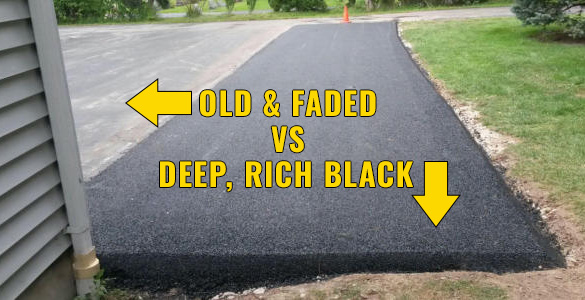Boost Sidewalk Performance: Cold Mix Asphalt Sealing Strategies
Boost Sidewalk Performance: Cold Mix Asphalt Sealing Strategies
Blog Article
Cold Mix Asphalt Vs. Hot Mix Asphalt: Which Is Right for You?

Structure Distinctions
Cold mix and hot mix asphalts vary considerably in their make-up, with distinct qualities that influence their performance and applications. Cold mix asphalt is created by emulsifying the asphalt binder with water and an emulsifying representative before mixing it with aggregate. This approach permits for the asphalt to be workable at lower temperature levels, making it excellent for short-term fixings and for use in colder weather. Warm mix asphalt, on the other hand, is produced at high temperature levels, commonly between 300-350 ° F, which assists to accomplish far better compaction and a much more long lasting last item. The warm mix asphalt production process includes warming the aggregate and asphalt binder individually before integrating them at the asphalt plant.
Additionally, chilly mix asphalt has a tendency to be less dense and much more flexible than hot mix asphalt. This flexibility makes it better suited for locations with greater degrees of motion, such as driveways or roads with rush hour. On the other hand, hot mix asphalt is recognized for its high sturdiness and resistance to rutting and breaking, making it a preferred choice for freeways and high-traffic roadways where durability is essential.
Installation Refine Variations
The process of installing cold mix and warm mix asphalt displays noteworthy variances in their treatments and needs. Cold mix asphalt, being a more adaptable product, can be applied directly from the bag or container onto the split or damaged location. It needs very little preparation job, such as cleaning up the area and compacting the chilly mix with hand devices. This makes it a practical option for fast and momentary fixes. On the other hand, hot mix asphalt necessitates a much more fancy installment process. It entails heating the blend to heats prior to laying it down on an effectively prepared base. The prep work includes condensing the base, using a tack coat, and making use of heavy equipment like pavers and compactors for a durable and smooth surface. Due to the heating needs, hot mix asphalt installments are normally accomplished by experts with customized devices, making certain a much more structurally audio and permanent result.
Resilience and Durability Aspects
When thinking about asphalt choices, resilience and durability are crucial variables to review for lasting pavement efficiency,. Warm mix asphalt (HMA) is understood for its phenomenal durability and longevity. The high temperatures throughout the blending and laying process permit far better compaction, causing a denser and more powerful pavement Find Out More structure. This leads to HMA being extra immune to rush hour lots, extreme weather, and the effects of maturing contrasted to cold mix asphalt (CMA)
In regards to longevity, HMA typically outshines CMA because of its superior toughness and resistance buildings. HMA sidewalks have a longer life span, calling for much less frequent repair services and maintenance, which can convert to cost financial savings in the future. Additionally, HMA sidewalks are more conveniently customizable to fulfill particular task requirements, better enhancing their longevity.
Cost Factors To Consider
Considering the monetary implications is an essential element when reviewing the option in between warm mix asphalt (HMA) and cold mix asphalt (CMA) for sidewalk tasks. While the initial right here expense of warm mix asphalt is typically greater than that of cool mix asphalt, HMA frequently supplies an extra cost-effective service over time as a result of its exceptional toughness and longevity. HMA is known for its ability to stand up to rush hour loads and rough weather, lowering the need for frequent see post repair work and maintenance. On the other hand, chilly mix asphalt is a lot more economical in advance however might need even more regular patching and resurfacing, bring about greater upkeep prices with time.
In enhancement to material prices, it's vital to consider the costs linked with setup and upkeep when comparing HMA and CMA. Inevitably, the decision in between HMA and CMA should take right into account not simply the preliminary price but likewise the lasting financial effects to determine the most economical alternative for the particular pavement task.
Environmental Impact Comparison
Comparison of the environmental impacts between hot mix asphalt (HMA) and cold mix asphalt (CMA) reveals distinct distinctions in sustainability practices. HMA manufacturing calls for high temperature levels, leading to increased power consumption and greenhouse gas exhausts.
In addition, the usage of CMA typically involves reusing existing asphalt pavement, advertising resource preservation and lowering the amount of waste sent out to garbage dumps. By deciding for CMA over HMA, road construction tasks can contribute favorably to environmental preservation efforts.
Final Thought
Finally, the choice between cool mix asphalt (CMA) and hot mix asphalt (HMA) depends upon numerous factors such as structure, installment procedure, toughness, longevity, expense, and ecological influence. asphalt patch repair. While CMA supplies a cost-efficient and quick service for minor fixings, HMA ensures exceptional toughness and long life for rush hour areas. Think about these aspects meticulously to establish which sort of asphalt is the right option for your paving needs

Considering the economic implications is a critical aspect when evaluating the option between warm mix asphalt (HMA) and cold mix asphalt (CMA) for pavement jobs. While the first cost of hot mix asphalt is typically higher than that of chilly mix asphalt, HMA usually offers a much more cost-efficient solution in the lengthy run due to its exceptional toughness and long life. angle parking.Contrast of the ecological influences in between warm mix asphalt (HMA) and cold mix asphalt (CMA) reveals unique differences in sustainability methods.In verdict, the selection in between cool mix asphalt (CMA) and warm mix asphalt (HMA) depends on numerous variables such as make-up, installation process, resilience, durability, expense, and environmental effect
Report this page